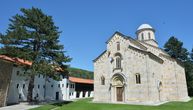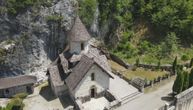"Where the crown falls, let a shrine be built": The Sretenje monastery legend
One of the nine monasteries in the Ovcar-Kablar gorge represents its spiritual treasure
In the "Serbian Mt. Athos" - as the Ovcar-Kablar gorge is referred to, there are nine monasteries, two chapels and one church that both domestic and foreign tourists like to visit when visiting Serbia.
In addition to the Blagovestenje, the monastery where the most beloved Serbian Orthodox Patriarch Pavle became a monk, the Sretenje monastery attracts special attention, both because of its unique appearance and because of its interesting origin story.
According to legend, a crown was thrown from the top of Ovcar, and a place of worship was to be built where the crown fell. The crown, again according to legend, first fell onto a cliff, and then rolled on another and stopped in a monastery valley known as "Koronski Do."
And exactly the place where the crown stopped, the faithful built the shrine, it will turn out located at the highest altitude of all the monasteries in the "Serbian Mt. Athos."
Although it is not known exactly when the Sretenje monastery was built, this place of worship is mentioned in Turkish writings at the beginning of the 16th century, which suggests that it was probably built earlier.
During a turbulent history, the monastery was destroyed and rebuilt several times.
It was first set on fire in 1623 by Tatars who served in the Turkish army, and was restored by Patriarch Gavrilo Raskovic.
Then the monastery was destroyed and abandoned during the Great Migration of Serbs in 1690.
A new restoration followed at the beginning of the 19th century, for which a monk was credited first, and then Bishop Nikifor Maksimovic. Believers had collected money so that Bishop Nikifor could travel to Jerusalem, but he assessed that the money would be used better and more justly to rebuild a shrine in Serbia. The choice was Sretenje.
This monastery, which is today considered the spiritual treasure of the Ovcar-Kablar gorge, was not spared in the Second World War either - it was bombed and then rebuilt in the second half of the last century. Then it became a nunnery.
The monastery keeps three manuscripts from the 16th century, the Gospel in silver fittings from the 18th century, which was received as a gift from Russia, as well as a metal chalice from the 18th century and a copperplate portrait of Bishop Nikifor.
Photo: Ivan Strahinic
(Telegraf.rs)

